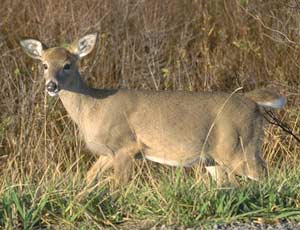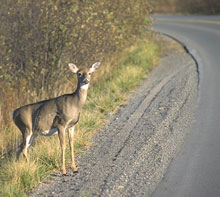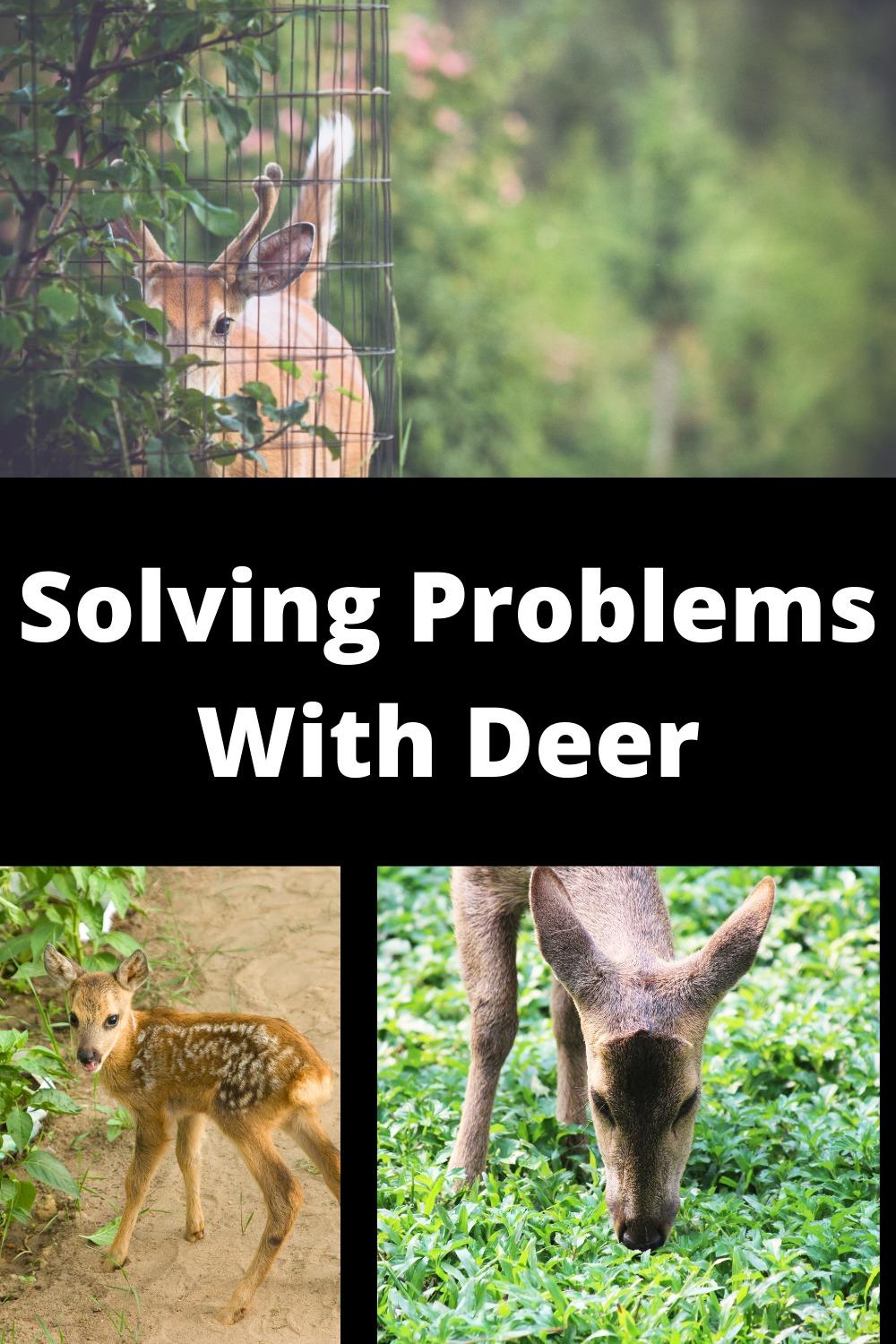
It was bound to happen sooner or later, and as gardener-versus-wildlife conflicts go, this one is comparatively new. But we've got to face it: There are more deer in the world than 20 years ago, and there are more people, especially in the suburbs and country. As an ecologist would put it, our respective habitats overlap more frequently than before.
Nevertheless, this overlap is causing traumatizing and sometimes expensive dilemmas for gardeners. In truth, there is no tidy solution. The only sensible option is to rely on a smorgasbord of big-picture and garden-level techniques.
 Name That Deer
Name That Deer
Of the 38 deer species worldwide, the whitetail in the East and mule deer in the West are the two that cause the most problems for American gardeners. Surveys estimate the current total deer population at approximately 30 million, compared to about 12 million a decade or so ago. Although the causes of this population explosion are elusive, the threat it poses to gardens and farms is clear.
Deer are a fecund species, and they produce multiple offspring when stressed. Over her average 10-year lifespan, a doe and her daughters can produce up to 100 fawns. In recent years, the incidence of twin and triplet fawns has increased.
Concurrently, residential and commercial development has encroached further into deer habitats, which also discourages herd-trimming activities of hunters and coyotes. Development also adds to garden and landscape plantings that provide more nutritious food sources than were available to deer in the past.
While science works on an effective contraceptive, gardeners struggle with a growing problem. Over the long term, effective planning could minimize future problems. On the community level, replacing widely spaced suburban lots with clustered homes and large undeveloped-land areas would preserve blocks of natural habitat large enough for hunters and animal predators like coyotes to reduce deer populations. Also, managers of public parks, highways, wooded watershed lands, private preserves, and corporate parks could reduce deer damage in residential areas by replacing ornamental plantings in nonresidential areas with species that provide habitat for wildlife.
What to Do
Specific strategies vary, depending on the local deer population, available food supplies, cost, plants' (and gardeners'!) damage-tolerance, and types of plants grown. Many solutions are available, but nothing is absolutely foolproof, or deer-proof. Here are some suggestions-ranked in order of effectiveness-and referrals to sources of additional helpful information.
Permanent Fences. For most homeowners, an 8- to 10-foot-high fence provides adequate protection but would be costly (at least $1 per foot) and possibly block views (some fences and walls may violate local zoning or design-control ordinances). In northern areas, a solid snowdrift would provide a convenient launchpad over such a fence for deer. Some gardeners opt for electrified fences baited with peanut butter. Fences of any type must be maintained, and the tall or electrified varieties can be dangerous for children and pets. In commercial or industrial areas, high walls and fences make sense, but for gardeners, an effective barrier against deer can be expensive and unsightly.
For more information about building a deer-proof fence, see Reducing Deer Damage to Home Gardens and Landscape Plantings, prepared for Cornell University's Wildlife Damage Management Program (Ithaca, NY 14853). For more about electrified fences, see Wildlife Pest Control Around Gardens and Homes, (Division of Agriculture and Natural Resources, University of California, Oakland, CA 94608-1239).
Mesh Fences. This product consists of 100-foot rolls of a black vinyl mesh that can be stapled to trees or posts. However, the materials, including any necessary posts and post-hole diggers, can be expensive. Also, the mesh is only 7 feet high, so it may not keep all deer out. Cost is approximately $20 per roll.
Temporary Fence. If keeping deer out is important but only seasonally, or if you don't want to invest in a permanent fence, here are some alternatives.
Seasonal Barriers. In early spring, when food sources for deer are depleted and new growth on shrubs, trees, and plants is appearing, gardeners can opt for lightweight barriers of fabric row covers over shrubs and small trees, or floating row covers over seedlings and transplants. Bird netting is not a deterrent to deer. They'll munch through it to the fruit you're trying to protect.
A note about netting: When sap starts to flow and later when fruit ripens, fruit trees, bushes, and vines are especially vulnerable to deer. Dormant trunks and twigs can be sprayed or wrapped, but most sprays are toxic, so leaves, buds, blossoms, and fruit would have to be draped with netting. That's difficult, however, because of their height, and large amounts of netting can be expensive. If it's in your budget, you could arrange to have wire cages installed around trees.
Wire Bed-cages. Small, wire cages around beds or individual plants rather than the entire property can protect plantings. If you place tops over them, they would not have to be electrified.
A less expensive option for vegetable gardeners is a modular wire cage over individual beds or a tunnel hoop draped with floating row cover. Both are easy to build and safer than electrified fences for gardeners, children, and pets. Small barriers also can be removed after harvest.
Motion-sensor devices that spray water or blast loud alarms when deer approach are not likely to deter deer for very long, and they may annoy neighbors.
Chemicals repellents are expensive and labor-intensive. Some powders and sprays leave an unsightly white residue on foliage. Many treatments require reapplication every 4 to 6 weeks and after heavy rainstorms. The USDA currently considers only two types, granular Milorganite (approved as a fertilizer, but used asa repellent) and Hinder (an odor-based repellent ) safe enough to use on edible crops. Research the recommended repellents for your area for detailed information on chemical options.
Other strategies such as spraying hot sauce and thyme oil, hanging human-hair sachets, pie pans, or crackling vinyl tape, or even loudly broadcasting all-night talk-radio shows may work, but only temporarily. Sprays and solutions must be refreshed, and gardeners must switch strategies as deer grow accustomed to each ploy. I haven't yet tried Bobbex (slaughterhouse waste) or coyote urine (yes, we all ask: how do they collect that stuff anyway), but gardeners report good results with both.
Dogs. Some homeowners with dogs have reported success in keeping deer away with a family pet acting as garden sentry. Dogs that can be left outdoors at night appear to do a good job. Combined with an underground electric fence that keeps the dog from straying, this approach is another one to consider.
Deer Repellent Plants
Lists of deer-resistant ornamental trees, shrubs, and flowers are available in commercial and government publications. Because different species of deer prefer different plants in different regions, no single plant list works for every garden. Western gardeners can still have evergreen hollies, but the evergreen choices in eastern gardens are limited to spruce and leucothes. In mild winter regions, good evergreens are boxwood and acuba. Norway maples are safe in eastern landscapes, but deer devour them out West. Consult regional plant lists compiled by local extension services.
Plants' resistance to deer depends more on the number of deer in the area and on the climate than it does on the types of plants. Except poisonous species, no plant is deer-proof. Foods that are ordinarily indigestible or even allergenic to deer may become daily menu items in situations of severe stress from weather or scarcity of other food. And if deer can digest a new food, your formerly repellent plant moves off the safe list and onto their regular menu.
Although thorns and briars pose no problems to them, the fibrous or fuzzy foliage of ferns, ornamental grasses, tarragon and wormwood (Artemesia), lamb's ears (Stachys) and borage-family plants like bugloss (Anchusa), borage, heliotrope, Virginia bluebells (Mertensia), forget-me-not (Myosotis), and lungwort (Pulmonaria) seem to be difficult for deer to swallow. Because silver and gray leaves are often furry and pungent, these plants are good deer-repellent choices for many gardens.
"Bad-tasting" to a deer means lemony, minty, sagey, spicy, or bitter. Pungent herbs are good garden choices. You can also plant some of the peppery flowers of the mustard family: alyssum, Arabis, aubrietia, snow-in-summer (Cerastium), dame's rocket (Hesperis), candytuft (Iberis), nasturtium, pinks, carnation, and sweet William, Lychnis, soapwort (Saponaria) and Silene.
Deer also avoid plants that people consider medicinal and poisonous: foxgloves (the plant source of the cardiac drug digitalin), poppies (the plant source of opium), daffodils, and lily-of-the-valley. Herbals and other literature on toxic plants list many other plants that are beautiful enough to include in the garden, but unappetizing to deer.
Give transplants tough love. Many young plants are lost to deer because fertilizer or ample watering made them temptingly tender. Nitrogen is the basic building-block of protein for deer and one of the "big three" plant nutrients, along with phosphorus and potassium. Fertilizer makes for numerous green leaves, but at the expense of weak cell walls. Feed the soil, not the plants, to make flowers and shrubs less appealing to hungry deer.
Newly purchased plants are also especially vulnerable to deer damage. Besides being coddled at the nursery with fertilizer and water, they face transplant stress. Cove them with floating row covers or temporary cages until they acclimate and reducing fertilizer will often get them safely through a critical period.
Because deer are browsers (brush eaters) rather than grazers (grass eaters), the sight of deer grazing the lawn may be a sign of excess soil nitrogen, either from fertilizer or even from leaking sewage. Amend your gardening and home-maintenance practices accordingly.
Plants in the wrong place for their sun, soil, and nutritional needs are the first to bebrowsed. Move your sun-loving plantings out of the shade and shade lovers out of the sun.
Other Strategies and Information Sources
Gardeners faced with foraging deer should collect as much on-site information as possible before planting gardens or trees. Most county extension offices maintain extensive files of useful information and provide it to you at minimal cost. Many publications contain clear drawings of effective fence designs, detailed evaluations of the effectiveness and cost of commercial repellents, and explanations of deer behavior and physiology to help you customize a protection plan for your garden.
In addition, a query on the Internet will produce an avalanche of information. You should also talk to farmers, nursery owners, and other gardeners in your area. They may have already made most of the potential mistakes!
Contrary to some gardeners' opinion, deer are not "hoofed rats". They're selective feeders whose dining preferences change to meet seasonal nutritional needs. Smart gardeners can use this knowledge to their advantage.
In temperate and cold-climate gardens, late winter and early spring are the most difficult foraging times for deer. Their vitamin and mineral needs soar just when juicy, sappy growth is scarce. Early-flowering shrubs and trees (including Japanese and sugar maples) are vulnerable. Except for forsythia and narcissus, later-blooming plants are good choices.
In fall, the need to stockpile calories to survive the winter drives deer to seek high-calorie foods full of oils and starches. Nut- or berry-bearing autumn ornamentals can draw the animals' attention from other garden plants. On large properties, dogwood, if planted away from vulnerable plantings, is an excellent choice because the oily berries support many species of wildlife, including deer. Crab apples and viburnums are also good for wildlife. Firethorn (Pyracantha), burning bush (Euonymus alata), and barberry provide winter food after their bitter berries have been softened by frosts. In small gardens or yards, deer will eat such plants before others.
Take a Hike
Plants that thrive in your local parks and preserves offer good hints about what will work in the home garden. Other than giant forest trees, you'll find abundant barberry, winged Euonymus, Japanese wineberry, and shrub and vine honeysuckles.
Remember to be Flexible
Knowing more about deer habitat and dining preferences and combining a variety of strategies allows gardeners to customize solutions to deer-damage problems for individual gardens.
Karen Jescavage-Bernard is an author and the manager of the Jane E. Lytle Memorial Arboretum in Croton-on-Hudson, New York.
Photography by the USDA

 Victory Seed Company has all the seeds you want for your best garden in 2024.
Victory Seed Company has all the seeds you want for your best garden in 2024.
For 25 years, the family-owned Victory Seed Company has provided the highest quality vegetable, herb and flower seeds to families across the country. We are passionate about providing you the best seeds available that give excellent germination, robust plants, and the harvest you want. With a catalog of over a thousand varieties, we have everything, and our prices are the kinds that we'd want to pay. We have hundreds of yesterday's heirloom vegetables, as well as today's award winning hybrid selections. Get to know us by visiting our website and browsing through our online vegetable seed catalog.